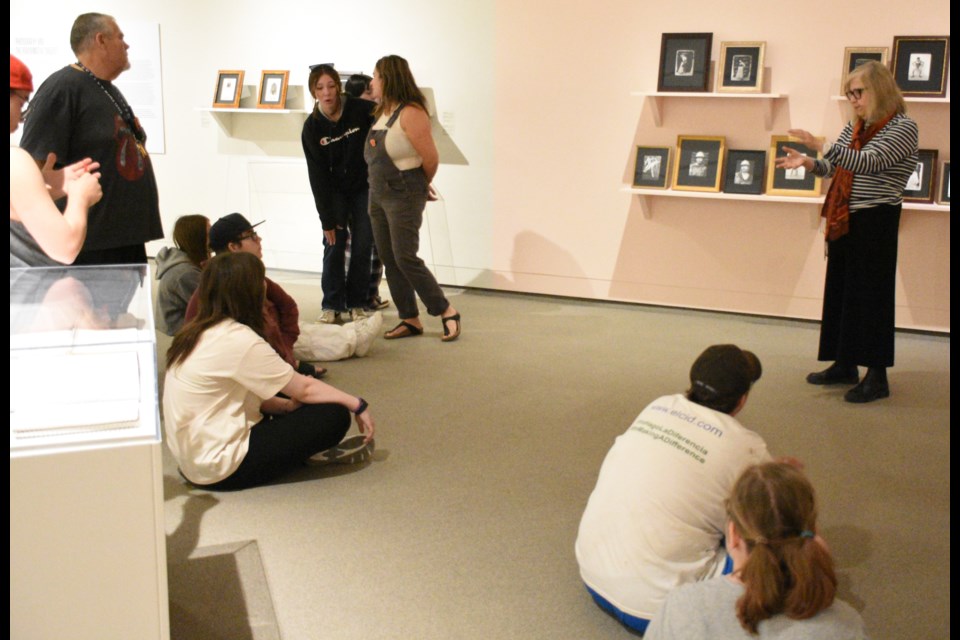MOOSE JAW - Artist Leesa Streifler is thrilled that many artworks she has created during the past 41 years — including some she hasn’t seen in decades — are now on display and showcase her views about the human body.
“Lessa Streifler: The Performance of Being,” is the newest exhibition at the Moose Jaw Museum and Art Gallery (MJMAG) and runs from Friday, Sept. 27 to Sunday, Dec. 8.
More than 100 mixed-media artworks from the 1980s to now comprise the exhibition and are divided into themes of Memory and Innocence; Fear, Anxiety, Sorrow and Rage; Performativity; and The Carnivaleque.
The display showcases Streifler’s interest in СŔ¶ĘÓƵ “othered,” representing gender performance, social control and body politics, patriarchy, motherhood, marginalized and non-conforming bodies, and the stages of life, including aging.
The MJMAG held an opening reception on Friday night, which featured comments from Streifler, curators Wayne Baerwaldt and Jennifer McRorie and art historian Joan Borsa. There was also a contemporary dance performance by Anastasia Evsigneeva.
MooseJawToday.com caught up with the Winnipeg-born artist on Sept. 26 after she gave a tour to a class from Riverview Collegiate.
In the beginning
Streifler — considered one of Canada’s leading feminist artists — received her bachelor’s degree in Winnipeg in the late 1970s and her master’s in New York in the early 1980s. She held one exhibition in The Big Apple, but because of the works’ quality, she didn’t consider it a professional show.
However, in 1985, a mentor from Winnipeg asked if she wanted to feature her work in his gallery, so she accepted. She later became a professor at the University of Regina in 1986 and remained there until 2019.
Human figures
Streifler, 67, explained that her work used to be more abstract but was always figurative and about “the figure” — usually her figure, what was happening to figures, the effect that the world and environment had on these СŔ¶ĘÓƵs, and what these figures thought of the world.
Moreover, the artworks showcased the interactions between couples and their love, sexuality, intimacy and romance. They also featured topics about identity, which Streifler said reflected her efforts to understand her identity as a woman.
“I’m a strong feminist,” the Winnipeger said, noting she learned about second-wave feminism in university in the 1970s and began learning about female artists.
Feminism’s influence
As Streifler grew and matured as a woman, she realized that other women’s experiences were important, while they were different than men’s and deserved to be represented. However, those were unpopular sentiments.
The art world told women then that topics such as mothering, domestic issues, self-awareness and the female body were unimportant.
“Even colour. Like, using the colour pink was considered not too serious. Like, pretty colours that were very pretty that I tended to like from clothing or from my life as a girl weren’t considered serious things,” Streifler said, noting the feminist movement changed all that.
Streifler’s early works expressed her anger toward society’s treatment of women and “the other,” while her recent work showcases her more compassionate nature.
She attributed this evolution to growing older and having more autonomy and power in her life. However, she still sees injustice in the world, so that anger is still there but is not as pronounced.
“I’ve still got both of them. But the proportions have changed a bit … ,” she remarked. “But, now I want to go home and do work about the wars that are going on in the world (and the powerlessness, fear and lack of control with them). And that’s going to be angry, so it’s subtle stuff.
“It’s not just black and white, right? There’s so many feelings that you have about life.”
The body and aging
Streifler’s most recent work focused on women and aging, the strength they have, and their anatomy. She noted that she is fascinated by how the body changes and continually draws it to understand it better.
These drawings are improving, but it’s difficult because she had a “more idealized body” as a younger woman and never focused on seniors. Moreover, art history usually features “gorgeous bodies,” so she had few examples of older bodies to study.
“It’s very hard to draw skin that sags (and) has wrinkles and … how the structure of the body changes, the posture, and everything,” Streifler said.
The artist created art that focused on motherhood, while she drew very few male bodies since she didn’t “know the reality of СŔ¶ĘÓƵ a man.”
Collected artwork
Streifler says she is thrilled that many artworks she created over four decades are now in one spot, while she credited various national and provincial art galleries and museums for keeping them in good shape. About 85 per cent came from those venues, while 15 per came from her personnel collection; she was relieved to free up space in her studio so she could create more.
She also appreciated that McRorie and Baerwaldt wrote such flattering words when describing the exhibit.
“It’s very great. I mean, it’s … humbling … ,” Baerwaldt said.
Streifler now lives in Winnipeg and is a mentor in a feminist organization called Mentoring Artists for Women’s Art (MAWA). She continues to create art and writes for a Canadian arts magazine.
Visit for more information.




